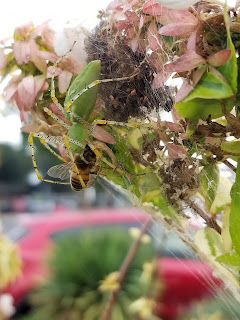As we gear up for Turkey Day next week, I thought I would pop a bit of knowledge into the back of your brain that you can share with dinner companions.
As you sit at the dinner table with your group, you can casually say "Did you know that there are allowable amounts of insects in our food?"
"No!" your companions will gasp.
"Yes!" you will insist. "I learned about it on this really great blog I read. You should subscribe to it!"
So, if you don't believe me about bugs in your food, check out this FDA site that has all the information you need for your conversation (and probably a bit more.....).
HAPPY THANKSGIVING!
Friday, November 17, 2017
Thanksgiving dinner conversation....
Friday, November 3, 2017
Green lynx spider
Today our Travis County Master Gardener volunteers were working in our demonstration garden to tidy things up. I always love when they come out as I get to interact with them directly with hands-on teaching moments. Today, I was not disappointed. One of them came in to see if I could tell them about a spider she found. You can look at the title to figure out what it was....
 Green lynx spiders are large, bright green spiders with slightly elongated abdomens and spiny legs. They are usually found on shrubs and low-lying vegetation where they wait for insects to come in so they can ambush them and eat them. Lynx spiders are generalist predators, which means that they do not specifically eat one type of food item, but a wide variety- generally whatever they can catch. While they are considered to be beneficial, they will eat pollinators (food is food!).
Green lynx spiders are large, bright green spiders with slightly elongated abdomens and spiny legs. They are usually found on shrubs and low-lying vegetation where they wait for insects to come in so they can ambush them and eat them. Lynx spiders are generalist predators, which means that they do not specifically eat one type of food item, but a wide variety- generally whatever they can catch. While they are considered to be beneficial, they will eat pollinators (food is food!).
The spiders that we found were mommas with babies...in this case, spiderlings. You can see in the photos webbing that encases part of the plant also holds and protects offspring. The female spider guards her spiderlings until they can fend for themselves.
 Spiderlings remain near the egg sac for a little over a week and then they disperse to new locations by ballooning. Ballooning is where spiderlings throw up a strand of silk to catch the wind which carries them to a new location. I hope that I am here when this happens as I found four lynx mommas with babies (that could be about 800 spiderlings!!).
Spiderlings remain near the egg sac for a little over a week and then they disperse to new locations by ballooning. Ballooning is where spiderlings throw up a strand of silk to catch the wind which carries them to a new location. I hope that I am here when this happens as I found four lynx mommas with babies (that could be about 800 spiderlings!!).





